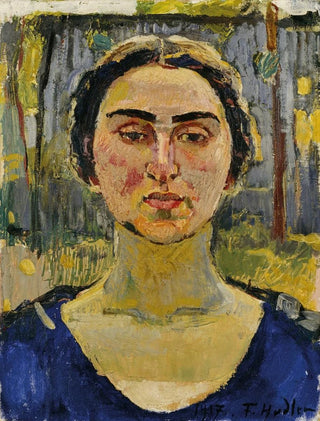Painting Portrait of Letizia Raviola - Ferdinand Hodler | Art print Source: Tableau Portrait de Letizia Raviola - Ferdinand Hodler | Reproduction


View from behind

Frame (optional)
The "Portrait of Letizia Raviola" by Ferdinand Hodler is a piece that transcends the simple frame of a portrait to become a true ode to beauty and human emotion. Created at the end of the 19th century, this painting embodies not only the exceptional talent of its creator but also the spirit of a rapidly changing era. Through the delicate features of Letizia Raviola, Hodler manages to capture an essence that is both intimate and universal, inviting the viewer to immerse themselves in a world where sensitivity and art meet. This work, emblematic of symbolism, reflects the artistic aspirations of its time, where the expression of the human soul was emphasized.
Style and uniqueness of the work
Ferdinand Hodler's style is distinguished by his bold use of colors and shapes, which create an atmosphere that is both vibrant and mysterious. In the "Portrait of Letizia Raviola," each brushstroke seems charged with meaning, each shade of color evokes an emotion. The composition is carefully thought out, with a subtle balance between shadows and lights that enhances the depth of the model's gaze. Letizia, with her gentle and melancholic expression, appears both present and distant, as if she were the reflection of an ephemeral dream. The meticulous details of her face and hairstyle testify to the artist's dedication to capturing beauty in its purest form. This portrait is not limited to depicting a woman but becomes an exploration of the soul, a silent dialogue between the artist and the viewer.
The artist and his influence
Ferdinand Hodler, an emblematic figure of Swiss art, knew how to mark his era with a unique style that combines symbolism and impressionism. His work is often characterized by a search for inner truth, a quest for authenticity that is evident in each of his portraits. Hodler was influenced by the artistic movements of his time, but he developed a personal approach that is entirely his own. His interest in the theme of duality and symmetry is also reflected in the "Portrait of Letizia Raviola," where the composition and pose of the model evoke an almost mystical harmony.

Matte finish

View from behind

Frame (optional)
The "Portrait of Letizia Raviola" by Ferdinand Hodler is a piece that transcends the simple frame of a portrait to become a true ode to beauty and human emotion. Created at the end of the 19th century, this painting embodies not only the exceptional talent of its creator but also the spirit of a rapidly changing era. Through the delicate features of Letizia Raviola, Hodler manages to capture an essence that is both intimate and universal, inviting the viewer to immerse themselves in a world where sensitivity and art meet. This work, emblematic of symbolism, reflects the artistic aspirations of its time, where the expression of the human soul was emphasized.
Style and uniqueness of the work
Ferdinand Hodler's style is distinguished by his bold use of colors and shapes, which create an atmosphere that is both vibrant and mysterious. In the "Portrait of Letizia Raviola," each brushstroke seems charged with meaning, each shade of color evokes an emotion. The composition is carefully thought out, with a subtle balance between shadows and lights that enhances the depth of the model's gaze. Letizia, with her gentle and melancholic expression, appears both present and distant, as if she were the reflection of an ephemeral dream. The meticulous details of her face and hairstyle testify to the artist's dedication to capturing beauty in its purest form. This portrait is not limited to depicting a woman but becomes an exploration of the soul, a silent dialogue between the artist and the viewer.
The artist and his influence
Ferdinand Hodler, an emblematic figure of Swiss art, knew how to mark his era with a unique style that combines symbolism and impressionism. His work is often characterized by a search for inner truth, a quest for authenticity that is evident in each of his portraits. Hodler was influenced by the artistic movements of his time, but he developed a personal approach that is entirely his own. His interest in the theme of duality and symmetry is also reflected in the "Portrait of Letizia Raviola," where the composition and pose of the model evoke an almost mystical harmony.
12,34 €






